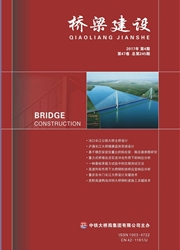

 中文摘要:
中文摘要:
为了解大跨度钢桁梁斜拉桥无砟轨道道床板脱空特性、指导结构优化,以主跨630m的钢桁梁铁路斜拉桥为研究对象,建立钢桁梁无砟轨道桥面局部分析模型,采用非线性弹簧单元和接触单元模拟道床板与弹性减振垫层的接触关系,计算不同位置处道床板的脱空量和脱空范围,对比不同道床板布置和不同弹性减振垫层刚度情况下的脱空量,并提出降低脱空量的优化方案。研究表明:跨越主横梁的道床板与底座板在板端区域存在脱空的可能性;脱空量与荷载作用位置及道床板布置方式有关,脱空区域主要在道床板端部,宜优先选择道床板在主横梁处断开的布置方式;弹性减振垫层两端刚度小、中间刚度大的布置方式较优,能在一定程度上降低道床板底部的脱空量和脱空范围。
 英文摘要:
英文摘要:
To have an understanding of the disengaging characteristics of the ballastless track bed slabs on long span steel truss girder cable-stayed bridge and to guide the optimization of the track bed slab structure, a railway steel truss girder cable-stayed bridge with a main span 630 m was taken as the research object. The local analysis model for the steel truss girder deck of the bridge laid with the ballastless track was set up, the nonlinear spring element and contact element were used to simulate the contact relationship between the track bed slabs and the elastic damping courses and the disengaging amounts and range of the track bed slabs at different positions were calculated. The disengaging amounts of the track bed slabs of different track bed slab layout and different elastic damping course stiffness were compared and the optimization scheme for reducing the disengaging amounts was put forward. The results of the study show that there exists the possibility of disengaging between the track bed slabs and their base slabs spanning the main cross beams in the areas of the slab ends. The disengaging amounts depend on the load acting po- sitions and the track bed slab layout ways, the disengaging areas are mainly nearby the ends of the track bed slabs and therefore, it is preferable that at the main cross beams, priority should be given to the choice of the layout way of the disconnected track bed slabs. The layout of an elastic damping course having low stiffness at both ends of the course and high stiffness in the middle is advantageous and the layout in such a way can reduce the disengaging amounts and range of the track bed slabs to a certain extent.
 同期刊论文项目
同期刊论文项目
 同项目期刊论文
同项目期刊论文
 期刊信息
期刊信息
